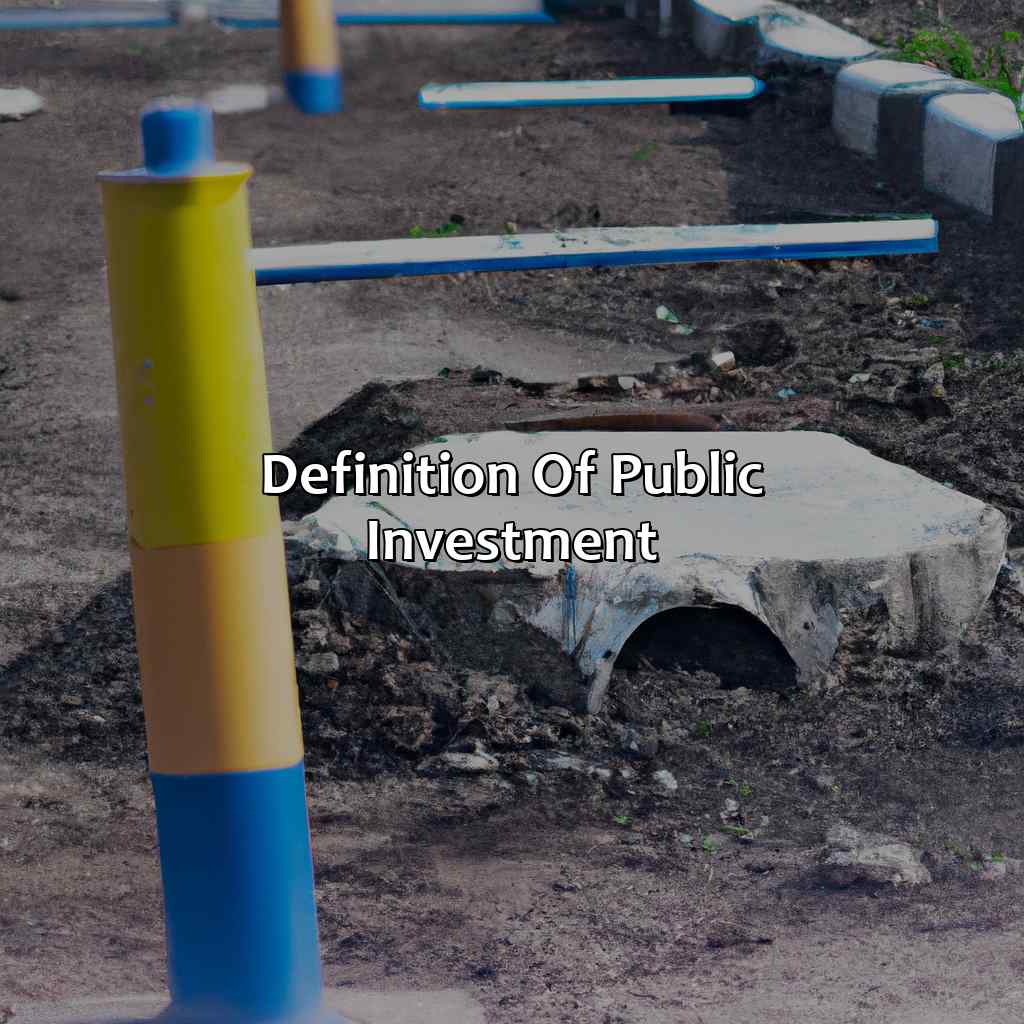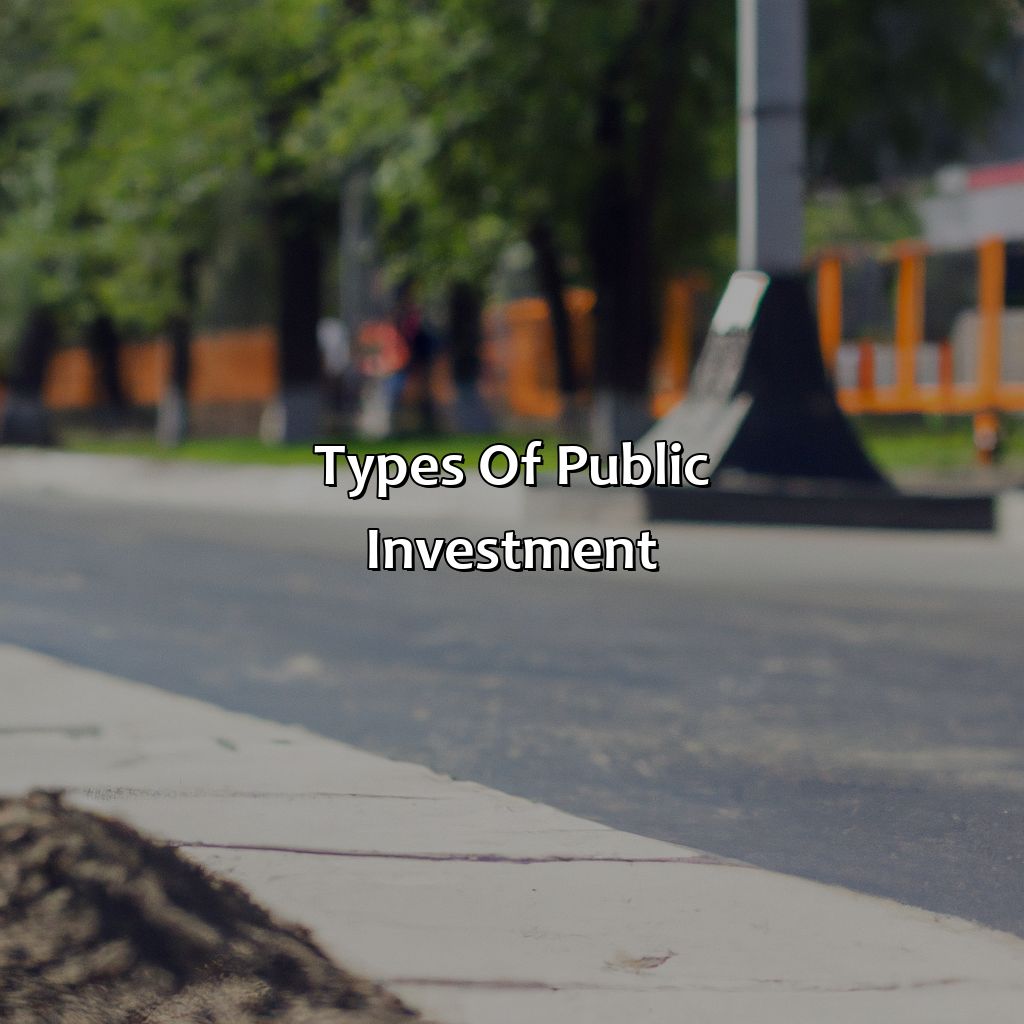What Is Public Investment?
Key Takeaway:
- Public investment refers to government spending on public infrastructure, capital investments, and public-private partnerships to improve society’s wellbeing.
- Public investment boosts economic growth, creates job opportunities, and improves the public’s quality of life by enhancing public infrastructure such as transportation systems and renewable energy.
- There are various types of public investments, including government spending, capital investments, and public-private partnerships, which can help achieve long-term societal and economic development goals.
Struggling to understand public investment and why it is important? You’re not alone. This article will help you understand what public investment is, its importance, and how it can help tackle some of life’s challenges. Get ready to be informed and empowered!
Definition of Public Investment
Public investment refers to the government’s spending on physical and social infrastructure, such as roads, bridges, schools, and hospitals. It includes all expenditures made by the government to enhance its long-term economic growth and promote the well-being of its citizens. Such expenditures are generally intended to produce benefits over an extended period, making them different from regular government expenses. Rather than benefiting the current generation, public investment aims to benefit future generations by creating sustainable infrastructure.
Public investment is a vital tool for economic development and results in the creation of jobs, improved social welfare, and economic growth. Without it, a country may be at risk of falling behind its international competitors and suffering from a lack of investment opportunities.

Image credits: retiregenz.com by Harry Arnold
Benefits of Public Investment
Want to find out the pros of public investment? This section will be your guide. It focuses on enhancing public infrastructure, jumpstarting economic growth and providing job opportunities. Take a look at each sub-section. You’ll learn how public investment can benefit society!

Image credits: retiregenz.com by James Washington
Improving Public Infrastructure
Enhancing the quality of public structures and systems yields substantial benefits for society. Public investment in infrastructure improves roadways, bridges, water supply systems, and public transportation networks. Furthermore, it speeds up emergency response services and emergency medical care through well-equipped hospitals. By promoting investment in infrastructure, governments can create job opportunities by attracting new businesses to invest in the locality.
Improving public infrastructure also has positive economic consequences such as enhanced productivity levels that fuel rapid development resulting from increased accessibility. Additionally, improved connections between rural and urban areas provide ample opportunities for expansion of markets. As a result of this progress, sustainability is guaranteed through the creation of green jobs along with development of renewable energy sources.
It’s worth mentioning that global economic models highlight the significance of investing in roads, railways and power grids to sustain worldwide economic growth while developed countries increase their competitiveness compared to emerging nations.
According to Forbes Magazine’s expert analysis on this topic, major U.S cities; New York City (NYC), Chicago and San Francisco plans to invest over $300 billion in critical infrastructures over the next few years creating over 4 million new jobs by 2025.
Public investment: stimulating the economy one dollar at a time, and providing employment opportunities for the financially challenged.
Boosting Economic Growth
Public investments have the potential to drive the economic growth of a nation. By increasing capital investment, governments can create more job opportunities, thereby boosting employment rates and consumer spending. This leads to an increase in demand for goods and services, which in turn spurs business growth and profitability.
Furthermore, public investment in infrastructure such as transportation systems and communication networks can produce further beneficial effects. It enables the movement of people and goods, fostering trade and commerce. Having access to fast and reliable means of communication allows businesses to collaborate more easily with partners in other regions or countries.
Investments in areas like education, healthcare, and innovation also spur economic growth. Enhancement of education results in a skilled workforce that meets the demands of increasingly complex jobs. With better health outcomes comes a more productive workforce with fewer absenteeism days due to illnesses. Innovation drives productivity by promoting new technologies which often lead to cost savings.
It is suggested that policymakers focus on high-quality public investment projects that promote long term economic growth rather than short-term objectives. Investment funds should be appropriately allocated ensuring equitable distribution throughout society instead of being concentrated on specific sectors or demographics benefiting few individuals while leaving others behind. These projects should aim at achieving sustainable development goals for greater societal benefit as well.
“Unemployment is like a bad penny, it always turns up – unless we invest in public projects that create job opportunities!”
Creating Job Opportunities
Investing in public infrastructure can lead to increased job opportunities. A boost in infrastructure spending creates a demand for jobs in various sectors, such as construction, engineering, and transportation. The resulting increase in employment not only positively impacts the economy but also enhances the standard of living of citizens.
Moreover, public investment can lead to longer-term economic growth, particularly if it is targeted at critical areas of infrastructure that drive productivity and competitiveness. By investing in schools, hospitals, transport systems and affordable housing projects, the government can create thousands of new jobs every year while also improving the quality of life of its citizens.
It’s worth considering that when governments make investments early on rather than waiting until later when repair work costs are significantly higher – they save taxpayers money over time. By investing now on long-term infrastructure projects which create jobs and support communities, we will be best positioned to weather any future economic downturns. Investing now may even help us prevent future recessions by creating a stable foundation for growth.
Don’t miss out on the benefits that public investment has to offer! Investing in public infrastructure creates opportunities for both present and future generations to live healthier lives with better job prospects – something we all desire!
If you’re a fan of variety, public investment has got you covered with a range of types like infrastructure, education, and healthcare. It’s basically the buffet of government spending.
Types of Public Investment
To get a grasp of the diverse Types of Public Investment and their perks, this article will discuss Government Spending, Capital Investments, and Public-Private Partnerships. These investments are essential for governments worldwide to reach public welfare and economic growth.

Image credits: retiregenz.com by Yuval Arnold
Government Spending
The allocation of government resources towards public works is critical to ensure the growth of a nation’s economy. Public investment enhances infrastructure, education, and healthcare sectors, among other areas that directly benefit citizens. These investments effectively channel funds to developmental sectors and create jobs.
Public investment takes different forms ranging from subsidies for businesses to direct financing for innovation in science & technology or transportation. Governments may also invest in non-profit ventures that help promote social justice and environmental concerns, such as affordable housing or reducing carbon emissions.
Moreover, investment in R&D (Research & Development) is another crucial form of public investment that can lead to sustainable economic growth by advancing technological progress.
Pro Tip: Adequate public investment can stimulate economic activity and create an environment conducive to long-term growth; however, mismanagement of these funds can lead to build-up of debt.
Capital investments: Because you can’t spell ‘public investment’ without ‘Banksy’.
Capital Investments
Public investment in assets with long-term benefits is referred to as investments that are made by governments, councils or public bodies. These investments are made to boost economic growth and development, fund infrastructure such as roads, bridges, buildings etc., and provide essential services like healthcare, education and social welfare programs. Capital expenditures usually involve high costs but have long-term benefits for the community.
Investments in capital assets can be categorised into several types:
- Social infrastructure investment that includes hospitals, schools, parks etc;
- Transport infrastructure investment that deals with constructing and maintaining roads, bridges, railways etc.;
- Environmental infrastructure investments like water management systems and renewable energy projects; and
- Investment in technological advancements like fibre network upgrades and smart city initiatives.
It’s important to note that capital investments help create a robust economic environment and serve as the backbone of a nation’s prosperity. Pro Tip: Allocation of capital expenditures requires careful planning and funding decisions through a well-defined process for maximum benefits.
Public-private partnerships: When the government tries to prove that they can work well with others, just like they learned in kindergarten.
Public-Private Partnerships
One of the types of investment used by the government is collaboration or partnership with private entities. The method is called a joint venture. Private enterprises have stronger financial positions, marketing abilities, and expertise in operating businesses, while public agencies provide essential infrastructure and utility systems.
The benefit of such an arrangement is that it enables costs to be shared among multiple parties. Another advantage is that both groups share technical knowledge to improve communication and cooperation between them. Meanwhile, responsibilities are divided between the two sides to maintain a fair balance.
Partnership arrangements vary depending on project specifications. For example, concession contractual agreements grant private enterprises exclusive rights to operate facilities for a specific period and only need minimal government intervention.
On the other hand, build-operate-transfer (BOT) contracts allow private businesses to fund construction costs for infrastructure projects in return for exclusive rights to operate or manage facilities following completion. With BOT arrangements, ownership gets transferred eventually to public agencies after the end of their tenure.
Successful PPP examples include sports venues or transportation infrastructure development where private firms handle system planning and management while allowing cities or governments substantial control over management operations.
A creative PPP project can be seen in Harvard University’s energy-saving contract signed in 2003 which allows investors like Citigroup Inc., Ausra Inc., and Johnson Controls; to pay expenses worth $10 million from installing new equipment like sustainable heating units during construction causing significant cost saving generating revenue worth $100 million without burdening taxpayers.
Looks like the government hit a home run with these public investments, unlike my dating life which is more like a strikeout.
Examples of Successful Public Investments
Understand high-return public investments? Look at examples like high-speed rail projects. Examine smart city initiatives too. Plus, consider expanding renewable energy. Every sub-section gives different views of how public investment can benefit society.

Image credits: retiregenz.com by Joel Jones
High-Speed Rail Projects
Efficient transportation infrastructure is crucial for economic growth and high-speed trains are a prime example of successful public investments. These transportation projects utilize advanced technologies and provide fast, safe, and comfortable travel experiences for commuters across vast distances. High-speed rail projects have various operational models, including intercity trains that run between two major cities or regional connectivity systems that link smaller towns to nearby urban hotspots.
These investments in sustainable mobility not only enhance economic productivity but also reduce congestion, pollution, and environmental damage caused by traditional modes of transportation. High-speed rail networks can also stimulate the development of peripheral regions that otherwise may not attract much investment. Moreover, the incorporation of renewable energy sources in their operation reduces carbon emissions and contributes towards mitigating climate change.
Pro Tip: Public-private partnerships are effective ways to fund large-scale high-speed rail projects where government funding may be limited.
Looks like cities are getting smarter, but the people living in them…not so much.
Smart City Initiatives
Innovative Urban Development Schemes are initiatives that use technology to develop smarter cities. These programs use data analytics, IoT devices and other advancements to improve the delivery of public services that promote economic growth, enhance livability, and increase sustainability. By implementing smart solutions into urban infrastructure like transportation systems, water supplies, and utilities, Smart City Initiatives facilitate better engagement between the community and government services in a cost-effective manner.
Moreover, organizations worldwide have been using innovative methods to harness existing technologies such as artificial intelligence (AI), Big Data Analytics, Blockchain, and Internet of Things (IoT) towards availing better city services. Using these advanced technologies helps to monitor essential departments in real-time – optimize inventory management strategies leading to reduced wastage in public infrastructures.
A pro tip for Smart City Initiatives would be developing partnerships with civil society groups so they can help shape the projects’ design and implementation processes. It is essential because citizens living within the area are also stakeholders and their views must be respected.
Looks like the future is bright for renewable energy, but let’s hope it’s not just a flash in the pan.
Renewable Energy Expansion
The expansion of clean energy sources has been a successful investment for policymakers. This environmentally friendly initiative has boosted job creation, contributed to energy independence, and reduced greenhouse gas emissions. Investment in renewable energy technology such as wind, solar, geothermal, and hydroelectric plants is a smart approach towards achieving sustainable development goals. The transition from fossil fuels to renewable energy is crucial in tackling climate change and ensuring a cleaner future.
One of the best examples of a successful public investment in renewable energy comes from Denmark. In 2015, Denmark received 42% of its electricity generation from wind power; it aims to reach 50% by 2020. It has become one of the world’s leading countries regarding wind power generation over the years from investments made by the government. Renewable energy achieved through investment can be further expanded globally if policymakers prioritize it by allocating public funds towards research and development.
Renewable energy expansion not only benefits the environment but also results in numerous socio-economic advantages such as technological advancement and employment opportunities. It attracts private sector investments, fosters innovation, and promotes self-sufficiency in electricity production – eventually leading to lower prices for consumers.
In India, farmers are benefitting from solar panel installation on their lands as they generate electricity while also providing shade for crops. Investment in alternative forms of energy such as solar panels brings electricity to remote areas where there was previously none – resulting in improved quality of life for those communities.
Public investment is like trying to build a puzzle with missing pieces, except the missing pieces are billions of dollars.
Challenges in Public Investment
To succeed with public investment, you must acknowledge its obstacles. Political polarization, regulatory problems, and funding issues are just a few of the roadblocks. To face these challenges, the following sub-sections will be explored:

Image credits: retiregenz.com by Harry Washington
Funding Limitations
Public investment faces budgetary limitations that could hinder the implementation of projects aimed to alleviate societal challenges. These limitations stem from various sources like fiscal capacity, conflicting priorities, and political will. It becomes challenging to fund public investment projects due to the scarce resources available.
The distribution of resources is also uneven, posing further funding difficulties for some regions or sectors. This situation exacerbates the current social inequality since eliminating such gaps may require hefty financial allocations which are not always possible.
It is worth noting that funding limitations are not solely short term but can last for ages and acquire different forms over time. Thus planning and adjusting expenditure priorities become essential in balancing long term objectives with more immediate needs.
Pro Tip: Professional financial advisors can help governments navigate the complex process of raising funds while staying within their budgets, hence mitigating potential challenges arising from funding limitations.
Political polarization is like a game of tug-of-war, except no one wins and everyone’s just left exhausted and bitter.
Political Polarization
The current societal polarization has impacted public investment decisions. Public investment strongly reflects the ideological differences in policy-making, which can obstruct necessary initiatives. This fragmentation can create diseconomies of scale and inefficiencies.
This political uncivil discourse affects bipartisan consensus-building and compromises the quality of funding in long-term strategic planning. Conflicting political ideologies lead to incompatible priorities that might neglect necessary investments for society’s common good.
It is essential to understand the origins of this political polarization, from income inequality to social justice issues, in order to achieve bipartisan consensus in public investment projects that can address those issues.
Without common agreement on the priorities and goals of public investment, the threats linked with urbanization, climate change, energy security, health, education, and infrastructure remain unaddressed.
It is indispensable to overcome ideological divides and debunk myths about public investment to ensure that critical long-term problems are tackled effectively. There cannot be any excuses for not investing wisely and collaboratively towards better economic growth and social development.
Trying to navigate regulatory hurdles in public investment is like trying to run a marathon in quicksand, uphill, and blindfolded.
Regulatory Hurdles
Navigating the parameters of legal compliance poses a significant challenge to public investment. Compliance measures with various regulatory bodies can be complex, time-consuming, and expensive, with deviations from regulations posing severe consequences for investments.
Amidst regulatory hurdles, decision-making requires careful analysis of risks associated with possible breaches or delays in approvals. Regulatory authorities vary based on factors such as jurisdiction, industry type, and project size. Interpreting policies and reporting requirements correctly becomes crucial to avoid penalties while maximizing returns.
Public investments must comply with various local, state/provincial, national laws in addition to international standards set by organizations such as the United Nations (UN) or the World Trade Organization (WTO). Despite harmonization efforts among some countries and regions like the European Union (EU), overlapping and unclear regulations pose challenges to investors releasing capital.
Adhering strictly to regulations is not always enough; appropriate due diligence of new regulation introduced may reduce investment risk. Seeking expert advice from legal counsel is recommended before investing in any project that involves regulatory hurdles. Staying up-to-date on evolving legislation and seeking consensus amongst stakeholders is another way to mitigate uncertainty surrounding regulation changes while boosting positive outcomes.
Some Facts About Public Investment:
Public investment refers to government spending on infrastructure, education, healthcare, and other public goods and services. (Source: Investopedia)
Public investment can stimulate economic growth and create jobs. (Source: Brookings Institution)
Public investment can help address inequality and improve social welfare. (Source: International Monetary Fund)
Public investment can be financed through various means, such as government borrowing, taxation, and public-private partnerships. (Source: Organisation for Economic Co-operation and Development)
Public investment requires careful planning, implementation, and monitoring to ensure effectiveness and avoid waste and corruption. (Source: World Bank)
FAQs about What Is Public Investment?
What is public investment?
Public investment refers to the government’s expenditure on public goods and services such as infrastructure, education, healthcare, and social welfare programs. It is funded by tax revenues, borrowing, and other sources of government income.
What are the benefits of public investment?
Public investment can lead to economic growth as it creates jobs, improves infrastructure, and promotes innovation. It also enhances social welfare by providing better services in education, healthcare, and housing.
How is public investment different from private investment?
The main difference between public and private investment is the source of funding. Public investment is funded by the government, while private investment is funded by private individuals or corporations. Private investment also aims to make a profit, while public investment aims to provide public goods and services.
How does public investment contribute to economic development?
Public investment is essential for economic development as it creates an enabling environment for private sector investment. It also improves human capital, encourages innovation, and enhances productivity. Public investment can also attract foreign investment, leading to further economic growth.
What is the role of government in public investment?
The government’s role in public investment is to plan, allocate, and manage resources efficiently to meet the needs of citizens. It should prioritize investments in key areas such as infrastructure, education, and healthcare, and ensure that projects are completed on time and within budget.
What are the challenges of public investment?
Some of the challenges of public investment include inadequate funding, inefficiency in resource allocation, corruption, and political instability. These challenges can result in delayed projects, cost overruns, and poor delivery of services, leading to public dissatisfaction and a loss of trust in government.
 Checkout this IRS Loophole
Checkout this IRS Loophole 
